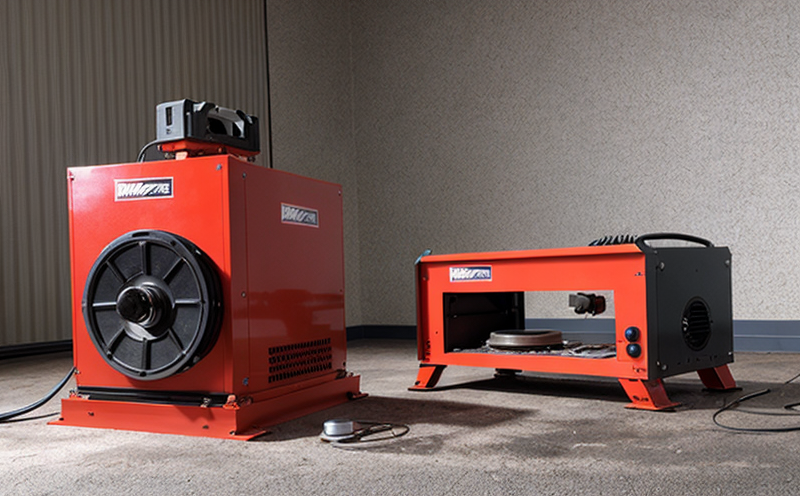ASTM D4577 Shock Impact Testing of Pallets
The ASTM D4577 standard provides a robust framework for testing the resilience and durability of pallets subjected to shock impacts. This service is essential for quality managers, compliance officers, R&D engineers, and procurement teams who are involved in ensuring that shipping containers meet stringent safety standards before deployment.
Shock impact testing according to ASTM D4577 is particularly critical in industries such as logistics, manufacturing, and distribution where pallets are repeatedly subjected to rough handling during transport. The test evaluates the ability of a pallet to withstand sudden impacts without sustaining damage that could compromise its structural integrity or functionality.
The standard specifies a pendulum-based impact machine capable of delivering controlled shock pulses to the pallet under test. This setup allows for standardized testing conditions, ensuring consistency and comparability across various samples. The test involves placing the pallet on a platform and subjecting it to repeated impacts from a swinging mass until failure occurs or a specified number of cycles is reached.
The primary outcome of this testing procedure is the determination of the maximum impact force that can be endured by the pallet without compromising its structural properties. This information is invaluable for quality assurance, as it helps identify potential weaknesses in design and manufacturing processes early on. Additionally, compliance with ASTM D4577 ensures that products meet international standards, thereby facilitating easier market entry into regions where these specifications are required.
For logistics professionals responsible for optimizing supply chain efficiency, understanding the shock resistance of pallets is crucial. By knowing how well a particular model performs under extreme conditions, they can make informed decisions about which types of equipment to use in different environments. In manufacturing settings, this knowledge allows engineers to refine designs so that materials used are better suited for anticipated stresses.
It's important to note that while ASTM D4577 focuses primarily on pallets made from wood or composite materials, its principles can also be applied more broadly when evaluating similar structures designed to absorb shock without failure. This makes it a versatile tool applicable across multiple sectors beyond just packaging and shipping.
- Customer Impact: Enhanced reliability of shipments leading to reduced costs associated with damaged goods.
- Safety Improvements: Reduced risk of accidents due to compromised pallets causing unsafe handling conditions.
- Increased Efficiency: Faster turnaround times for testing, enabling quicker identification and resolution of issues.
Why It Matters
The importance of ASTM D4577 shock impact testing cannot be overstated, especially given the increasing globalization of business operations. Effective logistics management relies heavily on reliable packaging solutions that can endure harsh transportation conditions without compromising their performance.
Incorporating ASTM D4577 into quality control protocols helps businesses maintain high standards of product integrity throughout distribution channels. This ensures that consumers receive goods in pristine condition, enhancing customer satisfaction and loyalty. Furthermore, adhering to this standard demonstrates a commitment to ethical business practices by prioritizing safety over expedience.
From an economic perspective, investing in robust testing procedures like those outlined in ASTM D4577 yields long-term savings for companies. By identifying design flaws early on through rigorous evaluation processes, manufacturers can avoid costly recalls and repairs later down the line. Moreover, compliance with international standards opens up new markets where stringent regulations are enforced.
Another significant advantage lies in improved safety metrics within organizations that handle large volumes of cargo daily. Implementing ASTM D4577 reduces the likelihood of accidents caused by weakened or poorly constructed pallets failing during handling operations. This not only protects employees but also maintains good standing with regulatory bodies, potentially avoiding penalties or fines.
Scope and Methodology
The scope of ASTM D4577 shock impact testing encompasses the evaluation of pallets' resistance to high-velocity impacts. The standard specifies detailed procedures for setting up the test apparatus, calibrating equipment, preparing specimens, conducting tests, recording data, and interpreting results.
To begin with, a suitable pendulum impact machine is calibrated according to manufacturer specifications. It must be capable of delivering precisely measured shock pulses within specified parameters defined by ASTM D4577. Once calibrated, the machine is used to repeatedly strike the pallet placed on a rigid stand. The frequency and intensity of these impacts are controlled meticulously to simulate real-world scenarios accurately.
Specimens undergo thorough preparation before being subjected to testing. This includes cleaning any dirt or debris from surfaces that may interfere with accurate measurements, ensuring all hardware components (e.g., metal fittings) are securely fastened so they do not become loose during impact events. Afterward, the pallet is positioned on the test platform according to prescribed alignment guidelines.
During each impact cycle, the force exerted by the pendulum is monitored continuously using sensors integrated into the machine. Data collected includes peak force values, duration of contact between the pendulum and the pallet, and any observable deformations or fractures resulting from the interaction. After completing a predetermined number of cycles (typically 10-50 depending on specific requirements), the test concludes.
The results are analyzed thoroughly to assess whether the pallet has sustained any damage that would affect its performance in subsequent usage. If no failures occur within specified limits, the pallet passes inspection; otherwise, it fails and needs redesign or repair before being approved for further use.





